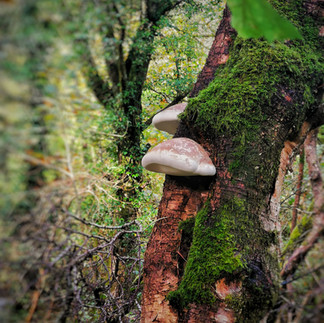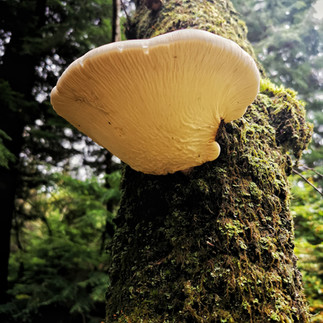Birch Polypore
- Zoë Hughes

- Nov 1, 2022
- 2 min read

I have a special affection for this mushroom because it has been used as medicine for at least 5,000 years. Plus it's the only mushroom you can confidently identify from a moving vehicle, that's to say that it’s very distinctive. With a little study and observation beginner foragers will be able to recognise Birch Polypore easily.
It has been the subject of scientific research for a few years so we are beginning to understand how this fungus benefits us. It has been shown to be anti-viral and could possibly treat HIV. Tests have shown it to be antibacterial, anti-inflammatory, anti-tumor, antioxidant, antifungal and antiparasitic too. A powerful medicine overall.
Key Features
Smooth white underside
Growing as a bracket off dead or living trees
Grows only on birch
Brown crust like markings on top, darker in older mushrooms
Sometimes the whole fungus is smooth like a marshmallow and sometimes it has a wavy base
Older specimens are best avoided
Found in all seasons
Lookalikes to be Aware of
Hoof Fungus
possibly Artists Fungus
It’s very easy to identify as nothing else looks like it, but there have been a few people who have mistaken Hoof Fungus for Birch Polypore, so give that a Google before you head out on the hunt for Birch Polypore.
Taste and Edibility
This is a powerful medicinal mushroom. It makes a bitter tea that can be made enjoyable with some added ingredients.
One of the reasons I love this mushroom is that it’s an incredibly ancient medicine. A mummy was found preserved in ice, believed to be 5,000 years old. He had a small portion of birch polypore on a leather string round his neck. The man was suffering from an intestinal parasite and was clearly in poor health, so archeologists believe he was using the birch polypore piece as a medicinal tea to treat the parasite.
As I often find with wild foods they like to ‘introduce’ themselves to me. When I first met a Birch Polypore I felt like it had flung itself at me insisting it say hello. I held it in my hands as it sprung from the tree and something about the cool, soft, sturdiness of it told me it was an important mushroom. I did some research about it and went back to harvest it when I was certain I knew what it was.
Birch Polypore is tough indeed. You need some welly to chop through it. Externally, it looks like a mushroom cloud hanging in the sky but cut it up and you’ll see how sturdy it is.
This is not a mushroom for dinner parties because it tastes very sour. Sometimes I use it as a stock if I want some bitterness to the dish, but in general I drink it as a medicinal tea. It’s easy enough to make: pop a few slices of it in a pot and cover with water, simmer for at least an hour, add honey or stock powder to taste.
It’s an accessible medicine because it grows all year and grows almost everywhere that birch grows. We have lots of birch forests on Arran so it’s easy to find in all the major woodlands. Just double check you’re not foraging inside an SSSI as lots of birch forests on the island are protected.
There are some reports of hallucinogenic experiences but this has not been seen in scientific studies. Personally, it gives me a little energy and an all round glow but no psychedelic experiences.












Comments